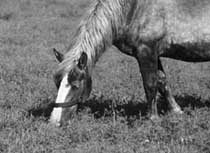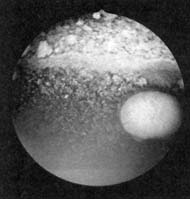Vitamin E and Motor Neuron Disease | Equine Clinical Research
THOROUGHBRED TIMES/ February 28, 1988
Reprinted with permission
E is for "ease"
Equine motor neuron disease (EMND) is another relatively new disease that affects the nervous system of horses, specifically those nerves controlling skeletal muscles. This disease in horses was first described in 1990 and has since been shown to resemble human amyotropic lateral sclerosis (Lou Gehrig's disease). Horses with EMND show a rapid onset of trembling, excessive recumbency, low head carriage, a constant shifting of weight on the rear legs, and muscle atrophy.
Equine degenerative myeloencephalopathy (EDM) is a disease of the spinal cord and brain stem. Affected horses show ataxia (incoordination), which occurs early in life and can stabilize or progress to become so severe that the horse must be euthanized.
What do EPM, EMND, and EDM all have in common? These three diseases have helped spark a renewed interest in the role of vitamin E in the horse. Researchers have found that horses who suffer from EDM have abnormally low levels of vitamin E, and supplementing the diet with vitamin E can lessen the disease in those horses already affected and help prevent it in foals if given before clinical signs of ataxia occur. Horses with EMND also have been shown to have low levels of vitamin E in their tissues and blood.
The absence of grazing time is a predisposing factor in EMND, and this reflects the inability of the horse to utilize pasture as a natural source of vitamin E. EPM is thought to be at least partially immune-based in that greater than 50% of all horses have been exposed to the parasite, while a very small percentage of horses actually gets the disease. Vitamin E is felt to be an immune system stimulator and, consequently, vitamin E supplementation is being highly recommended in affected horses.
These diseases and others have made vitamin E the focus of research and clinical testing and have changed the current recommendations for this nutrient in equine diets.
Vitamin E is one of the fat-soluble vitamins along with A and D. These vitamins must be supplied by the diet. Quality grass pastures and properly harvested hay are good natural sources of these vitamins. Horses not allowed sufficient grazing time or horses that graze poor quality pasture are more likely to have lower levels of vitamin E. Supplementation for many horses is, therefore, justified. There are actually a number of different derivatives of vitamin E to choose from when trying to supplement equine diets. One form, d-alpha-tocopherol, is relatively unstable, and reaction to oxygen in the air causes it to lose potency quickly. Esterified forms of vitamin E are more stable and are converted to active forms following absorption in the body. Another derivative, dl-alpha-tocopherol acetate, is considered by many nutritionists to be the most potent form of vitamin E. It is this form that is commonly used in feed supplements.
There has been a gradual increase in the National Research Council (NRC) estimates for vitamin E over the past ten years. Research that has shown improved performance and some possible benefits to muscle function during exercise has helped raise the recommended levels.
Many supplements have been released on the market recently, however, which do supply higher levels of vitamin E. These products make it easy to add vitamin E at levels up to 5,000 IU daily. Caution is urged to keep the selenium level at 1.5 to 2 milligrams daily even when feeding high amounts of vitamin E. Selenium is another important dietary compound that works synergistically with vitamin E and is sometimes sold in supplement form together with vitamin E. Problems can occur if such a vitamin E/selenium supplement is fed to achieve beneficial effects from high levels of vitamin E. The dose of selenium is then increased and toxicity problems can definitely occur from this mineral.
Reprinted with permission
 |  | |
| QUALITY GREEN PASTURES Horses that are not allowed sufficient grazing time or who are inefficient grazers may need vitamin E supplements | THE EYES HAVE IT Damage(brown pigment) to a horse's pupil occurs as a result of vitamin E deficiency |
E is for "ease"
Vitamin E may ease the symptoms of motor neuron disease and other stressors
by Kenneth Marcella, D.V.M.
Equine protozoal myeloencephalitis (EPM) is a parasitic disease that affects the brain, spinal cord, and nervous system. It can cause mild signs of incoordination in some horses and can quickly make other horses so unstable they cannot get up. It is currently a "popular disease," with many horses being tested and treated because of the recent increase in cases nationwide and the great variability of clinical signs that makes EPM resemble many other problems.Equine motor neuron disease (EMND) is another relatively new disease that affects the nervous system of horses, specifically those nerves controlling skeletal muscles. This disease in horses was first described in 1990 and has since been shown to resemble human amyotropic lateral sclerosis (Lou Gehrig's disease). Horses with EMND show a rapid onset of trembling, excessive recumbency, low head carriage, a constant shifting of weight on the rear legs, and muscle atrophy.
Equine degenerative myeloencephalopathy (EDM) is a disease of the spinal cord and brain stem. Affected horses show ataxia (incoordination), which occurs early in life and can stabilize or progress to become so severe that the horse must be euthanized.
What do EPM, EMND, and EDM all have in common? These three diseases have helped spark a renewed interest in the role of vitamin E in the horse. Researchers have found that horses who suffer from EDM have abnormally low levels of vitamin E, and supplementing the diet with vitamin E can lessen the disease in those horses already affected and help prevent it in foals if given before clinical signs of ataxia occur. Horses with EMND also have been shown to have low levels of vitamin E in their tissues and blood.
The absence of grazing time is a predisposing factor in EMND, and this reflects the inability of the horse to utilize pasture as a natural source of vitamin E. EPM is thought to be at least partially immune-based in that greater than 50% of all horses have been exposed to the parasite, while a very small percentage of horses actually gets the disease. Vitamin E is felt to be an immune system stimulator and, consequently, vitamin E supplementation is being highly recommended in affected horses.
These diseases and others have made vitamin E the focus of research and clinical testing and have changed the current recommendations for this nutrient in equine diets.
Vitamin E is one of the fat-soluble vitamins along with A and D. These vitamins must be supplied by the diet. Quality grass pastures and properly harvested hay are good natural sources of these vitamins. Horses not allowed sufficient grazing time or horses that graze poor quality pasture are more likely to have lower levels of vitamin E. Supplementation for many horses is, therefore, justified. There are actually a number of different derivatives of vitamin E to choose from when trying to supplement equine diets. One form, d-alpha-tocopherol, is relatively unstable, and reaction to oxygen in the air causes it to lose potency quickly. Esterified forms of vitamin E are more stable and are converted to active forms following absorption in the body. Another derivative, dl-alpha-tocopherol acetate, is considered by many nutritionists to be the most potent form of vitamin E. It is this form that is commonly used in feed supplements.
There has been a gradual increase in the National Research Council (NRC) estimates for vitamin E over the past ten years. Research that has shown improved performance and some possible benefits to muscle function during exercise has helped raise the recommended levels.
Effects of E
Stimulation of the immune system is a noted response to high levels of vitamin E and its effects as a free radical scavenger have also been documented. Free radicals are molecules that have an unpaired electron in their composition. These are unstable molecules and they contribute to tissue damage at the cellular level. These molecules are produced in small amounts during normal metabolic processes but are greatly increased during trauma, stress, and disease. Vitamin E helps stabilize these radicals and stops the destructive process. Still other effects of high vitamin E intake are being noted. William Vandergriff, Ph.D., an equine nutritionist based in Georgia, feels that high vitamin E levels are "showing success even with broodmares in that supplementation during the last trimester leads to healthier foals and ease in breeding the mare back." Because of the many beneficial actions of vitamin E, the NRC recommendations for daily intake have been raised from 15 IU (International Units) to 80 IU in 1989 to 250 IU in 1997.* Harold Hintz, Ph.D., a nutritionist at Cornell University, and others in the veterinary community have further increased those levels to 450 IU for maintenance, 720 IU for late gestation, 950 IU for lactation, and 1,000 IU for intense work. There are reports from England and Ireland of trainers using up to 15,000 IU daily in attempts to get improved performance. While there have been no reports of vitamin E toxicity in the horse, long-term effects of such high levels have not been adequately researched and most nutritionists are reluctant to recommend them.| Which horses should be given supplemental vitamin E? | |
| Any horse at risk for showing signs of EPM, EMND, or EDM | 6,000 to 10,000 IU |
| Young foals or aged horses. Horses on poor pasture or kept in stalls. Diseased, injured or stressed horses | 400 to 600 IU |
| Broodmares in late gestation | 720 IU |
| Lactating mares | 950 IU |
| Horses in intense training or competition | 1,000 IU |
Many supplements have been released on the market recently, however, which do supply higher levels of vitamin E. These products make it easy to add vitamin E at levels up to 5,000 IU daily. Caution is urged to keep the selenium level at 1.5 to 2 milligrams daily even when feeding high amounts of vitamin E. Selenium is another important dietary compound that works synergistically with vitamin E and is sometimes sold in supplement form together with vitamin E. Problems can occur if such a vitamin E/selenium supplement is fed to achieve beneficial effects from high levels of vitamin E. The dose of selenium is then increased and toxicity problems can definitely occur from this mineral.